So you’re wondering what the best ping pong paddle is for you? You’ve come to the right place. Here you’ll find an honest review of what type of paddles are available, some of the differences you need to look out for and which paddles suit different types of playing style.
This review is targeted at recreational table tennis players as we only cover pre-made paddles. If you’re a professional player, you will not find much use from it as you’ll be customising your paddle.
We hope you find our recommendations useful. Just so you know we may collect a small commission from links on this page.
Short on time? Below is a summary of our recommended paddles.
| Paddle | Speed | Spin | Control | Our Rating | More info | |
|---|---|---|---|---|---|---|
 |
Killerspin JET200 Best Beginner |
60 | 70 | 85 | 8.0 | Read more |
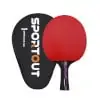 |
Sportout Sriver-He Beginner |
90 | 90 | 80 | 7.5 | Read more |
 |
Palio Expert 3.0 Beginner |
60 | 90 | 100 | 7.0 | Read more |
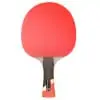 |
STIGA Pro Carbon Best Intermediate |
99 | 100 | 80 | 9.0 | Read more |
 |
Idoraz Table Tennis Paddle Intermediate |
99 | 93 | 90 | 8.0 | Read more |
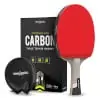 |
PRO SPIN Elite Series Intermediate |
90 | 80 | 80 | 7.5 | Read more |
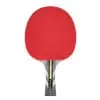 |
STIGA Raptor Best Advanced |
99 | 100 | 80 | 9.5 | Read more |
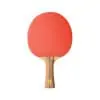 |
Killerspin JET 800 Advanced |
95 | 90 | 80 | 9.0 | Read more |
 |
Butterfly Pro Line Advanced |
N/A | N/A | N/A | 9.0 | Read more |
Best Ping Pong Paddles for Beginners
Killerspin JET200
Speed: 60 | Spin: 70 | Control: 85 | Weight: 6.4 oz | Blade: 5 layers of durable wood | Design: 3 colours | Handle: Shake hand design
- Provides good control
- Consistently in top 5 Amazon best sellers
- Great value
- Small handle with some build quality issues
- New colour handle dye can smudge
What we like:
If you had been looking for an entry level paddle over the last 5 years, you would be familiar with the Killerspin JET200. The paddle has been consistently rated as one of the best ping pong paddles for beginners and has had a recent design update.
The JET200 provides a balance of performance with an entry level price tag. What we like about the Killerspin JET200 is that it plays well compared with cheaper paddles. It provides the player with enough control to keep themselves in the rally against spin and power players. The paddle also produces a little spin, which is great for beginners who are still working on technique and mastering the various strokes.
Who’s it for:
Casual players that have stepped up their office ping pong game.
What else could you consider?
There are so many paddles available these days in the beginner category and more new players are entering the market each year.
Sportout Sriver-He
In 2019, the Sportout Sriver-He paddle came on the scene and boy, were we surprised! The blade uses a hybrid wood 9.8 (9 ply ayous wood + 8 ply carbon) and provides a solid base to cater for both power attacking and defending.
The Sriver-He rubber is also impressive with a 2mm sponge, providing decent bounce and great driving capability. Customer feedback around the build quality – particularly the rubbers peeling – prevented the Sportout from becoming our number one pick. Although they appear to have a good customer service team so definitely worth a look.
Palio Expert 3
Another paddle to consider is the Palio Expert 3. This 3rd generation paddle of the popular Palio Expert series was also released in 2019. The Expert 3 comes with a few improvements including wider edge tape, to help keep the rubbers secure, and a redesigned handle to provide more control.
The Palio Expert 3 is a defensive paddle so you will not generate much speed. But it provides great control for beginners and allows lots of spin to be generated with little effort. We found it easy to play defensive push and block strokes but some of the more attacking shots required more effort.
Like the Sportout Sriver-He, the Palio has also received some criticism for the construction quality. Though it’s not enough to stop us from recommending it as a great beginner paddle.
> Read more reviews for Beginner ping pong paddles under $50
Best Ping Pong Paddles for Intermediate Players
STIGA Pro Carbon
Speed: 99 | Spin: 100 | Control: 80 | Weight: 7.2 oz | Blade: 7-Ply extra light blade | Carbon technology | ITTF Approved | 2mm Sponge | Handle: Shake hand design
- Comfortable – light with a long handle
- Very fast & bouncy
- Performance-Level Table Tennis Racket
- Limited spin
- Average durability of rubbers
What we like:
Players that are looking to step up in performance will experience a world of difference with the STIGA Pro Carbon. Like the JET200, the Pro Carbon has been on the top sellers list and for good reason.
For a premade paddle, it’s one of the best we and many other players have come across. It provides a great balance of weight between the blade and rubbers for players that are developing an attacking playing style.
The STIGA Pro Carbon uses the Stiga S5 rubber – an ITTF approved inverted rubber with little complexity. This rubber is made for players who love the flat hitting and smashing power game. The amount of control and pace that can be generated is amazing for a paddle under $100.
While it may lack in generating spin, we recommend the STIGA Pro Carbon for players that are looking to move from beginner to pro.
Who’s it for?
Players that are getting a little serious about their game wanting to move away from beginner paddles.
What else could you consider?
Idoraz Table Tennis Paddle
One of our favourite paddles of 2019 and continues to be in 2020 is the Idoraz Table Tennis Paddle. You should consider it, because its about half the price of the STIGA Pro Carbon and plays extremely well.
The paddle is made for the defensive player, with a softer wood blade at its core. Its ITTF approved rubbers have a medium level of tackiness which help generate a decent amount of spin.
But the balance and control is what makes this paddle stand out. Boasting a 2mm sponge, defensive shots are quite effortless and backspin strokes can be well controlled. Beginners on the rise can develop their spin game with this paddle, against opponent’s with both speed and spin.
PRO SPIN Elite Series paddle
Another new paddle that we noticed in 2019 is the PRO SPIN Elite Series paddle. It has received some positive reviews by hundreds of customers so we thought we would also check it out.
The Elite series is a paddle for the all rounder, providing high speed, spin and control attributes. It uses a 7-ply light weight blade including 2 carbon layers that help enhance power and speed. It also comes with its own Pro Level Rubber that sits on a 2mm sponge layer.
The build quality of the paddle is solid and the rubbers feel strong and durable. We found the speed to be the paddles best attribute, with a large sweet spot area for flat attacking shots. There appears to be a slight imbalance of the light weight blade and heavier rubber which did not provide any strong control or spin.
With a price tag half of the STIGA Pro Carbon we feel the Pro Series has a lot going for it.
Best Ping Pong Paddles for Advanced Players
STIGA Raptor
Speed: 99 | Spin: 100 | Control: 80 | Weight: 7.5 oz | ITTF Approved | Blade: 7-Ply extra light | Carbon technology | 2mm Sponge | Handle: Shake hand design
- Comfortable – light with a long handle
- Very fast
- Higher levels of spin than Pro Carbon
- Expensive
Why we like it:
We’ve recently seen the introduction of an improved version of the STIGA Pro Carbon – The STIGA Raptor. While the two share similar characteristics, the blade in the Raptor has been re-engineered to enhance the speed and spin.
These enhancements make it stand out enough to be classified as an entry level paddle for the Advanced player. This is an important point, because paddles in this category are priced at anywhere upto $350. The Raptor is still available for under $100.
The biggest difference between the Pro Carbon players will recognise is the amount of spin it can produce. The difference is noticeable. Both topspin loops and backspin chops were executed with ease. The paddle feels like it has a similar sweet spot area as its sibling. Although the amount of speed on the attacking loops is impressive and comparative to top end paddles.
Ultimately, this is one of the best paddles we have played with in 2020 and feel like it has huge potential to overtake the Pro Carbon as the fan favourite.
Who’s it for:
Anyone that wants to experience a high quality paddle – from beginners to experts.
What else could you consider?
Killerspin JET 800
A pro player will always buy their blade and rubbers separately. But our aim is to provide the amateur players a guide on the best premade paddles on offer.
With that in mind, the options of high quality premade paddles suitable for advanced players are limited. The Killerspin JET 800 though is one that makes the list.
The JET800 blade consists of 7 layers – 5 layers of premium wood between 2 layers of carbon fiber. This blade was created for flat hitting attacking play. Compared with the STIGA Pro Carbon, we found this to generate much more speed. While it also provides a larger sweet spot to help with defending and helps absorb hard hitting shots.
The rubbers used on the JET800 are the celebrated Nitrix-4Z inverted ITTF approved rubber. Known for their high-tension and mid level tackiness, they provide a balanced mix of grip and hardness that attacking players love.
You won’t find much spin with this paddle and the overall feel is not as controlled as the Raptor. But it’s definitely a paddle that you should not discount.
Butterfly Pro Line
On the other end of the spectrum, you will find a premade paddle from Butterfly that will burn a slight hole in your pocket. The Butterfly Pro Line is effectively a custom paddle for the pros that is delivered to you premade.
The Pro Line is similar to a Rolls Royce in the table tennis world. Made in Japan, the attacking paddle is made from lightweight balsa wood including carbon layers. It is categorised as having Mid Fast speed and weighs in at around 10 ounces when factoring in the rubbers.
It comes with a Tenergy 80 FX rubber which provides the ultimate balance in spin and speed. The rubber enables all-round topspin play and is well suited for blocking and smashing. Lots of players rate this paddle as providing a perfect combination – an insane amount of spin while still giving very good control.
It’s not a paddle that is designed or recommended for beginners. The rubbers themselves take some time to get familiar with even for advanced players. But priced over $200 you need to be really serious about your game before considering this purchase. If you do though, it will change your game completely.
Ping Pong Paddle Buying Guide
Playing ability
The first and most important consideration when buying a ping pong paddle is your skill level.
For recreational players, we use the following levels to categorise playing ability:
Beginner:
- You’re new to the game and are not concerned with style of play.
- Your focus is on getting comfortable with the basic strokes.
Intermediate:
- You may have been playing for a few years and won your fair share of games.
- You know the difference between defensive and offensive strokes but still not sure exactly when to play them.
Advanced:
- You’re a regular player that has mastered both defensive and attacking strokes.
- You have a preferred playing style and you may have won a few tournaments against friends or colleagues.
Paddle Grip
There are two ways a player holds a table tennis paddle – the penhold and shakehand grip. Whatever your preference will influence the type of paddle you will buy.
The Penhold grip is where a player holds the paddle between his thumb and index finger. It’s not a common grip and can be difficult for beginners to use. The paddles are usually smaller with a short, thicker handle.
The shakehand grip is where a player holds the handle in the palm of their hand. This mimics someone shaking hands and is the traditional grip used by most players. Our reviews focus on paddles that are favourable for the shakehand grip.
Components of the paddle
The blade
The blade is the inner layer of the paddle which sets its foundation. All the other parts of the paddle connect to the blade, so it has a significant impact on game play. According to ITTF rules, the blade must be made from at least 85% natural wood. Other materials including carbon fibre, glass fibre or compressed paper are also used.
The materials used in the blade help define its density and flexibility. These properties then help determine how the ball will react on impact with the paddle. So we generally define blades in one of three categories:
- Offensive: these blades are stiffer with hard outer plys of wood. They are more suited to offensive players as they increase the amount of speed a player can generate.
- Defensive: these blades use soft and flexible plys of wood. They give the player better ball control and are suited to the defensive player.
- All round: these types of blades use a combination of hard inner plys with softer outer plys. They provide good control with a medium level of speed and suited for most players.
The Handle
Unlike the ITTF rules for blades, the handle does not have any restrictions. There are a few common types of handle styles outlined below. We recommend trying them all to help decide your own personal preference.
You want to find a handle that is comfortable to hold and provides the right responsiveness to help give you a feel for the impact of the ball.
Flared (concave) handles are the most popular. They follow a shape that is thinner at the top than at the bottom.
Straight handles, as the name suggests, follow a consistent and straight shape. They can either have rounded profile, which would be the majority, or square.
Like the flared handle, Anatomic handles have curves at the top and bottom. Their difference is that they curve outward (like a convex lens) in the middle, which help mould to a players palm.
The Rubber
The rubber is the most recognized feature of a table tennis paddle and almost everyone is familiar with its red and black color. The use of color is an official rule by the ITTF to ensure players see the side of the paddle their opponent is striking the ball.
Rubbers also have the biggest impact on the trajectory of the ball. The right rubber can help a player execute amazing spin shots or flat, fast-paced drives.
The ITTF provide an approval mark for rubbers. So if you’re planning to play in an authorised table tennis tournament you must use an ITTF approved rubber.
The main differences to look out for with rubbers are:
- Sponge thickness: the area between the top-sheet of the rubber and the wood, is called the sponge. They act similar to a trampoline to impact the way the ball bounces off. Sponges can range in thickness from 1mm to 2.5mm. Thicker sponges (between 2-2.5mm) are suitable for more attacking play whereas thinner rubbers (between 1-1.5mm) for defensive players.
- Pimples: no not the ones you might find on your face! Rubbers usually have pips or pimples that can face inward (toward the blade) or outward (the side that connects with the ball).
Simply put, outward facing pimples are suitable for more defensive players. Shorter pimples are useful for players who block and counter attack. Longer pimples are more suited for general defending, especially against spin.
Inverted rubbers (pimples facing inward) hit the ball with the smoother surface. This popular rubber type suits attacking players who use spin, due to a larger contact area with the ball. Players will find it easier to control the ball with this type of rubber.
Paddle attributes
Manufacturers will almost always provide a self assessed rating of their paddles. Their testing process can vary but they usually provide ratings for the following:
Speed
The speed attribute looks at how quickly the ball comes off the paddle. Speed ratings depend on many factors, such as the blade and rubber type, but it is useful when comparing rubbers. Most attacking players focus on generating more speed.
Spin
The spin value refers to the amount of ball spin a paddle can generate from a stroke. Spin is not only influenced by the stroke played and the paddle used, but also the speed and spin of the incoming ball.
There are a variety of spin strokes, which suit both attacking and defending styles, such as topspin, backspin and even side spin. It’s good to know your preferred playing style to determine how much spin you need.
Control
The definition of control can vary between manufacturers. Without a standard defined its difficult to use this when comparing paddles. For many manufacturers it refers to the players ability to control the ball with the paddle.
You’re unlikely to see a paddle with high speed, spin and control. But faster rubbers do generally have a lower control rating. Control is a feature that is more associated with defensive players, as they like to control the tempo and direction of their opponent.
Frequently Asked Questions
How do I choose a ping pong paddle?
There are quite a few considerations for a player when buying a ping pong paddle. This includes the players skill level, their playing style (attacking or defensive), their grip and their budget. Once these have been agreed on more detail can be spent on comfort, paddle vibration and how it plays. We have more detail on this in our ping pong buying guide.
Why do ping pong paddles have 2 colours?
You will almost always find a ping pong paddle that has a different colour on each side. The colours are usually red and black and represent the different types of rubber a competitor has used. Each rubber can have different characteristics that allow the player to utilise each side of the paddle in a certain way.
For example, the red side on a paddle may provide more spin, so the player may choose to use that side for their backhand defence.
How much do ping pong paddles cost?
Ping pong paddles can vary from anywhere between $5 and $600. There are some unique blades such as the Nittaku Resoud that will cost you over $2,700. These paddles are rare and are not common for professional tournament play.
What is the best table tennis racket brand?
After the many paddles we have tested, there is not one brand that we can safely say is the best. In fact, there are many quality table tennis brands that make some amazing paddles. These include STIGA, Butterfly, Killerspin and many more. You can read more on our review of the best premade ping pong paddles that we have found.
Are expensive ping pong paddles worth it?
This depends on the intended use of the paddle and what a player will classify as expensive. We recommend first that players should buy a paddle based on their playing ability and overall intended use. For example, if you’re only a casual once a week player that is learning the game then a beginner paddle would be a good place to start.
Similarly, if you feel that spending over $50 for a paddle is expensive, then keep to paddles that are within your budget.
Like with any product, you can occasionally overpay for a paddle. But we have often found that the more you pay for a paddle the longer it will last and it almost always provides more playing satisfaction.


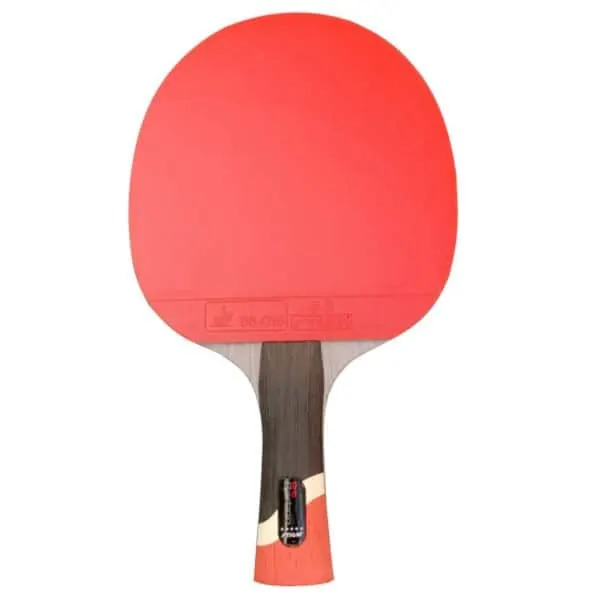
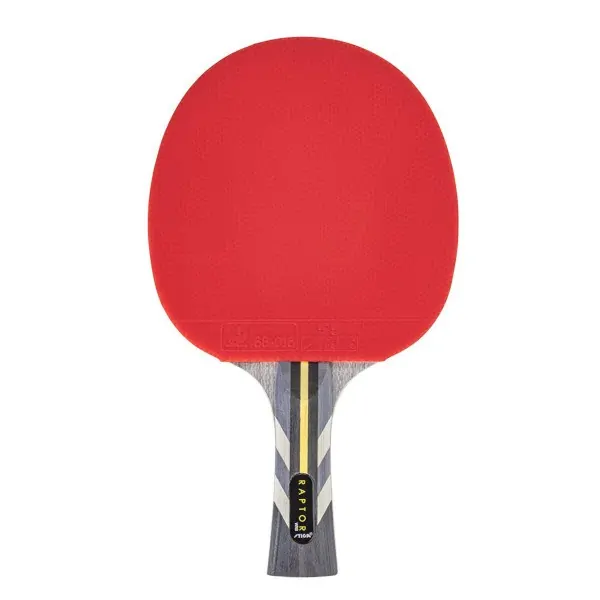
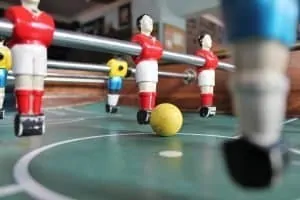
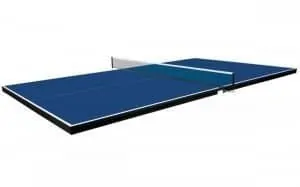

One Response
I’m getting a stiga space saver table. 71″ x 40″. I’m wondering what kind of paddle is best for a smaller than regulation table. We are beginners.
thanks